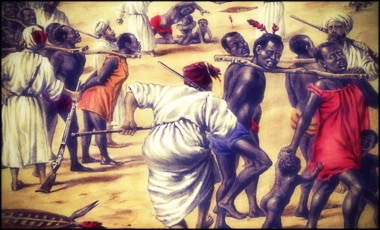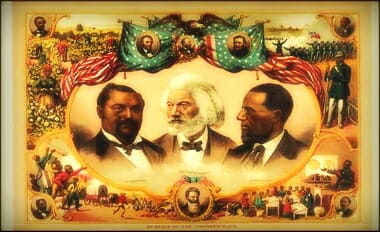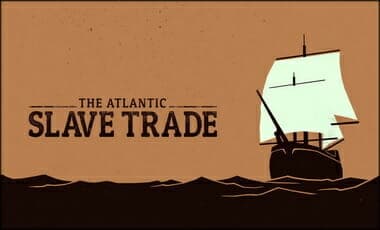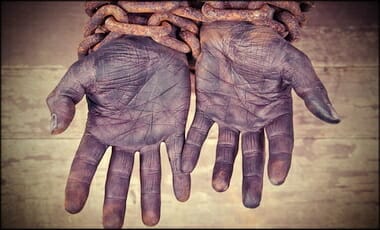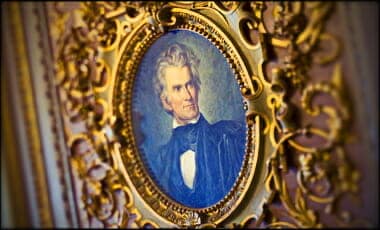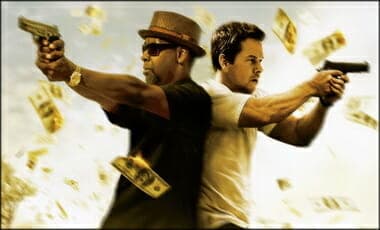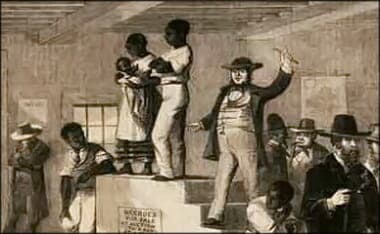[p. 15>] Early Black Economic Achievement
The portrayal of blacks as helpless victims of slavery and later gross discrimination has become part of the popular wisdom. But the facts of the matter do not square with that portrayal.
Despite the brutal and oppressive nature of slavery, slaves did not quietly acquiesce. Many found ways to lessen slavery’s hardships and attain a measure of independence. During colonial days, slaves learned skills and found that they could earn a measure of independence by servicing ships as rope makers, coopers, and shipwrights. Some entered more skilled trades, such as silversmithing, gold beating, and cabinetmaking.
Typically, slaves turned over a portion of their earnings to their owners in exchange for de facto freedom. This practice, called self-hire, generated criticism. “As early as 1733-34, a Charles Town, South Carolina, grand jury criticized slaveholders for allowing their slaves ‘to work out by the Week,’ and ‘bring in a certain Hire’ which was not only Contrary to a Law subsisting, but a Great Inlet to Idleness, Drunkenness and other Enormities!’ Later, a group of Virginia planters said, “Many persons have suffered their slaves to go about to hire themselves and pay their masters for their hire,’ and as a result ‘certain’ slaves lived free from their master’s control.” “Two ambitious Charles Town bricklayers, Tony and Primus, who spent their days building a church under the supervision of their master, secretly rented themselves to local builders at night and on weekends.”
[p. 16>] Many slaves exhibited great entrepreneurial spirit despite their handicaps. Even slave women were often found growing and selling produce in the South Carolina and Georgia Low Country. After putting in a day’s work, some slaves were allowed to raise their own crops and livestock. These efforts allowed them to gain a presence in much of the marketing network on the streets and docks of port cities. Ultimately, the South Carolina General Assembly passed a law requiring that slave-grown crops and livestock be sold only to the master. However, the law was very difficult to enforce, particularly among blacks who had gained knowledge of the marketplace. Market activity by slaves was so great that North Carolina whites mounted a campaign to stop slave “dealing and Trafficking” altogether. In 1741, that state passed a law prohibiting slaves from buying, selling, trading, or bartering “any Commodities whatsoever” or to raise hogs, cattle, or horses “on any Pretense whatsoever.”
During the colonial period, some slaves bought their freedom and acquired property. In Virginia’s Northampton County, 44 out of 100 blacks had gained their freedom by 1664, and some had become landowners. During the late eighteenth century, blacks could boast of owning land. James Pendarvis owned 3,250 acres in St. Paul’s Parish in the Charleston District of South Carolina. Pendarvis also possessed 113 slaves. Cabinetmaker John Gough owned several buildings in Charleston and others in the coastal South. During the late eighteenth and early nineteenth centuries, free blacks in Charleston had established themselves as relatively independent from an economic standpoint. As early as 1819, they comprised thirty types of workers, including ten tailors, eleven carpenters, twenty-two seamstresses, six shoemakers, and one hotel owner. Thirty years later, there were fifty types, including fifty carpenters, forty-three tailors, nine shoemakers, and twenty-one butchers.
New Orleans had the largest population of free blacks in the Deep South. Though they could not vote, they enjoyed more rights than blacks in other parts of the South—such as the right to travel freely and to testify in court against white people. “They owned some $2 million worth of property and dominated skilled crafts like bricklaying, cigar making, carpentry, and shoe making.” New Orleans blacks also created privately supported benevolent societies, schools, and orphanages to assist their impoverished brethren.
[p. 17>] Black entrepreneurs in New Orleans owned small businesses like liquor, grocery, and general stores capitalized with a few hundred dollars. There were also some larger businesses, for example, grocers like Francis Snaer, A. Blandin, and G. N. Ducroix, each of whom was worth over $10,000 ($209,000 in today’s currency). One of the best-known black businesses was owned by Cecee Macarty, who inherited $12,000 and parlayed it into a business worth $155,000 at the time of her death in 1845. Another was Thorny Lafon, who started out with a small dry-goods store and later became a real estate dealer, amassing a fortune valued over $400,000 ($8 million today) by the time he died. Black control of the cigar industry enabled men like Lucien Mansion and Georges Alces to own sizable factories, with Alces hiring as many as 200 men. Twenty-two black men listed themselves as factory owners in the New Orleans registry of free Negroes, though it is likely that most of these were one-man shops.
Pierre A. D. Casenave, an immigrant from Santo Domingo, was among New Orleans’ more notable businessmen. Having inherited $10,000, as a result of being a confidential clerk of a white merchant-philanthropist, Casenave was in the “commission” business by 1853. By 1857, he was worth $30,000 to $40,000, and he had built an undertaking business, catering mostly to whites, that was worth $2 million in today’s dollars.
Most free blacks in New Orleans were unskilled laborers. Males were employed on steamboats and as dockworkers and domestic servants, while females found work largely as domestic servants or washwomen. However, the ratio of skilled to unskilled workers among blacks was greater than among Irish and German workers. Indeed, free blacks dominated certain skilled crafts. According to J. D. B. DeBow, director of the 1850 census, in New Orleans that year there were 355 carpenters, 325 masons, 156 cigar makers, ninety-two shoemakers, sixty-one clerks, fifty-two mechanics, forty-three coopers, forty-one barbers, thirty-nine carmen, and twenty-eight painters.
In addition, there were free Negro blacksmiths (fifteen), butchers (eighteen), cabinetmakers (nineteen), cooks (twenty-five), overseers (eleven), ship carpenters (six), stewards (nine), and upholsterers (eight).” Robert C. Reinders, a historian, says that DeBow may have exaggerated the data to show that New Orleans had more skilled blacks than elsewhere; however, other evidence points to free-black prominence in skilled trades—for [p. 18>] example, 540 skilled blacks signing a register to stay in the state between 1842 and 1861. Plus, travelers spoke of “Negro artisans being served by Irish waiters and free Negro masons with Irish hod carriers:’ A few black skilled workers were relatively prosperous. Peter Howard, a porter, and C. Cruisin, an engraver, were each worth between $10,000 and $20,000. A. Tescault, a bricklayer, owned personal and real property valued at nearly $40,000.
By the end of the antebellum era, there was considerable property ownership among slaves in both the Upper and Lower South. Many amassed their resources through the “task” (or “hiring-out”) system. In Richmond and Petersburg, Virginia, slaves worked in tobacco factories and earned $150 to $200 a year, plus all expenses. By 1850, slave hiring was common in hemp manufacturing and in the textile and tobacco industries. In Richmond, 62 percent of the male slave force was hired; in Lynchburg, 52 percent, in Norfolk, more than 50 percent, and in Louisville, 24 percent. Across the entire South, at least 100,000 slaves were hired out each year.
Self-hiring was another practice with a long tradition. It benefited both the slave and slave owner. The latter did not have to pay for the slave’s lodging and clothing. Slaves, although obligated to pay their masters a monthly or yearly fee, could keep for themselves what they earned above that amount. Frederick Douglass explained that while employed as a Baltimore ship’s caulker, “I was to be allowed all my time; to make bargains for work; to find my own employment, and collect my own wages; and in return for this liberty, I was to pay him [Douglass’ master] three dollars at the end of each week, and to board and clothe myself, and buy my own calking [sic] tools.” Self-hire, Douglass noted, was “another step in my career toward freedom:’
Not every self-hire slave fared so well. Some were offered the prospect of buying themselves only to see the terms of the contract change. Slaves who earned larger sums than originally expected were required to pay the extra money to the master. Sometimes slaves who made agreements with their masters to pay a certain price for their freedom were sold shortly before the final payment was due.
So intense was the drive to earn money that some slaves were willing to work all day in the fields, then steal away under cover of darkness to work for wages, returning to the fields the next morning. Catahoula Parish (Louisiana) plantation owner John Liddell sought legal action, telling his [p. 19>] lawyer, “I request that you would forthwith proceed to prosecute John S. Sullivan of Troy, Parish of Catahoula, for Hiring four of my Negro men, secretly, and without my knowledge or permission, at midnight on the 12th of August last 1849 (or between midnight and day).”
So common was the practice of self-hire that historians have described the people so employed as “Quasi-Free Negroes” or “Slaves Without Masters:’ In 1802, a French visitor to New Orleans noticed “a great many loose negroes about:’ Officials in Savannah, Mobile, Charleston, and other cities talked about “nominal slaves,” “quasi f.n. [free Negroes],” and “virtually free negroes,” who were seemingly oblivious to any law or regulation. In the Upper South—Baltimore, Washington, Norfolk, Louisville, Richmond, and Lexington, Virginia, for example—large numbers of quasi-free slaves contracted with white builders as skilled carpenters, coopers, and mechanics, while the less skilled worked as servants, hack drivers, and barbers. The quasi-free individuals, more entrepreneurial, established market stalls where they traded fish, produce, and other goods with plantation slaves and sold various commodities to whites. Historian Ira Berlin said, in describing the pre-staple crop period in the Low Country of South Carolina, “The autonomy of the isolated cow pen and the freedom of movement of stock raising allowed made a mockery of the total dominance that chattel bondage implied.”
William Rosoe operated a small pleasure boat on the Chesapeake Bay. Ned Hyman, a North Carolina slave, amassed an estate “consisting of Lands chiefly, Live Stock, Negroes and money worth between $5,000 and $6,000 listed in his free Negro wife’s name:’ Whites in his neighborhood said “he was a remarkable, uncommon Negro” and was “remarkably industrious, frugal & prudent…. In a word, his character as fair and as good—for honesty, truth, industry, humility, sobriety & fidelity—as any they (your memoralists) have ever seen or hear of:’
Thomas David, a slave, owned a construction business in Bennettsville, South Carolina, where he built houses as well as “several larger buildings.” He hired laborers, many of whom were slaves themselves, and taught them the necessary skills. This practice of slaves entering the market and competing successfully with whites became so prevalent that a group of the latter in New Hanover County, North Carolina, petitioned the state legislature to ban the practice. But despite statutes to the contrary, slaves continued to work as mechanics (as such workers were then called), contracting on [p. 20>] their own “sometimes less than one half the rate that a regular bred white Mechanic could afford to do it.”
In Tennessee, it was illegal for a slave to practice medicine; however, “Doctor Jack” did so with “great & unparalleled success,” even though he was forced to give a sizable portion of his earnings to his owner, William Macon. After Macon died, Doctor Jack set up his practice in Nashville. Patients thought so much of his services that they appealed to the state legislature: “The undersigned citizens of Tennessee respectfully petition the Honourable Legislature of the State to repeal, amend or so modify the Act of 1831, chap. 103, S [ect]. 3, which prohibits Slaves from practicing medicine, as to exempt from its operation a Slave named Jack…”
Women were also found among slave entrepreneurs. They established stalls and small stores selling various products. They managed modest businesses as seamstresses, laundresses, and weavers. A Maryland slave recalled, “After my father was sold, my master gave my mother permission to work for herself, provided she gave him one half [of the profits].” She ran two businesses, a coffee shop at an army garrison, and a secondhand store selling trousers, shoes, caps, and other items. Despite protests by poor whites, she “made quite a respectable living.”
With the increasing number of self-hire and quasi-free blacks came many complaints and attempts at restricting their economic activities. In 1826, Georgia prohibited blacks from trading “any quantity or amount whatever of cotton, tobacco, wheat, rye, oats, corn, rice or poultry or any other articles, except such as are known to be usually manufactured or vended by slaves.” Tennessee applied similar restrictions to livestock. Virginia enacted legislation whereby an individual who bought or received any commodity from a slave would be given thirty-nine lashes “well laid on” or fined four times the value of the commodity.
Similar measures were enacted elsewhere. In addition to statutes against trading with slaves, there were laws governing master-slave relationships. North Carolina decreed in 1831 that a master who allowed a slave to “go at large as a freeman, exercising his or her own discre[t]ion in the employment of his or her time… shall be fined in the discretion of the court” In 1835, the North Carolina General Assembly enacted a measure “for the better regulation of the slave labourers in the town and Port of Wilmington…. That if any slave shall hereafter be permitted to go at large, and make his own contracts to work, and labour in said town, by [p. 21>] consent, and with the knowledge of his or her owner or master, the owner of the said slave shall forfeit and pay one hundred dollars . . . said slave shall receive such punishment as said commissioners or town magistrate shall think proper to direct to be inflicted, not exceeding twenty-five lashes.”
Similar statutes were enacted in most slave states. In the 1830s, a South. Carolina court of appeals ruled as follows: “if the owner without a formal act of emancipation permit his slave to go at large and to exercise all the rights and enjoy all the privileges of a free person of color, the slave becomes liable to seizure as a derelict”
A New Orleans newspaper, the Daily Picayune, complained that hired-out slaves had the liberty “to engage in business on their own account, to live according to the suggestions of their own fancy, to be idle or industrious, as the inclination for one or the other prevailed, provided only the monthly wages are regularly gained.” In 1855, Memphis’ Daily Appeal demanded the strengthening of an ordinance prohibiting slaves from hiring themselves out without a permit. One citizen complained that “to permit the negro to hire his own time sends a slave to ruin as property, debauches a slave, and makes him a strolling agent of discontent, disorder, and immorality among our slave population.”
Much of the restrictive legislation was prompted or justified by the charge that some slaves were trafficking in stolen goods. But there was also concern that the self-hired and quasi-free would undermine the slavery system itself by breeding discontent and rebellion among slaves in general. Despite all the legal prohibitions, the self-hire and quasi-free practices prospered and expanded. Some slave owners who had sired children felt that, although they might not set those offspring free, they would allow them to be quasi-free and to own property. Other owners considered it simply sound policy to permit slaves a degree of freedom as a reward for good work. Even owners with a strong ideological commitment to the institution of slavery found it profitable to permit self-hire, particularly for their most talented and trusted bondsmen.
By the 1840s and ’50s, many masters were earning good returns on slaves who found employment in Baltimore, Nashville, St. Louis, Savannah, Charleston, and New Orleans. In 1856, white builders in Smithfield, North Carolina, complained that they were being underbid by quasi-free blacks in the construction of houses and boats, and criticized white contractors who pursued such hiring practices. Whites in the Sumter District [p. 22>] of South Carolina protested that “The law in relation to Slaves hiring their own time is not enforced with sufficient promptness and efficiency as to accomplish the object designed by its enactment.”
The fact that self-hire became such a large part of slavery simply reflects the economics of the matter. Faced with fluctuating demands for the labor of slaves, it sometimes made sense for owners to let a slave hire himself out rather than to sit idle, in return for securing a portion of his outside earnings. Slaves favored hiring out because it gave them a measure of freedom; it also provided some income to purchase goods that would be otherwise unattainable.
Free Blacks in the North
Free blacks played a significant economic role in northern cities. In 1838, a pamphlet titled ‘A Register of Trades of Colored People in the City of Philadelphia and Districts” listed fifty-seven different occupations totaling 656 persons: bakers (eight), blacksmiths (twenty-three), brass founders (three), cabinetmakers and carpenters (fifteen), confectioners (five), and tanners (thirty-one). Black females engaged in businesses were also included in the register: dressmakers and tailoresses (eighty-one), dyers and scourers (four), and cloth fullers and glass/papermakers (two each).
Philadelphia was home to several very prosperous black businesses. Stephen Smith and William Whipper had one of the largest wood and coal yards in the city. As an example of the size of their business, they had, in 1849, “several thousand bushels of coal, 250,000 feet of lumber, 22 merchantmen cars running between Philadelphia and Baltimore, and $9,000 worth of stock in the Columbia bridge:’ At his death, Smith left an estate worth $150,000; he had earlier given an equal amount to establish the Home for the Aged and Infirm Colored Persons in Philadelphia and had also donated the ground for the Mount Olive Cemetery for Colored People.
Another prosperous enterprise among early Philadelphia blacks was sail-making. Nineteen black sail-making businesses were recorded in the 1838 Register. James Forten (1766-1841), the most prominent of them, employed forty black and white workers in his factory in 1829. Stephen Smith was another black entrepreneur, a lumber merchant who was [p. 23>] grossing $100,000 annually in sales by the 1850s. By 1854, Smith’s net worth was estimated at $500,000, earning him a credit entry as the “King of the Darkies w. 100m. [with $100,000]”‘
Blacks dominated Philadelphia’s catering business. Peter Augustine and Thomas Dorsey were the most prominent among them. Both men earned worldwide fame for their art, with Augustine often sending his terrapin as far away as Paris. Robert Bogle was a waiter who conceived of the catering idea in Philadelphia by contracting formal dinners for those who entertained in their homes. Nicolas Biddle, a leading Philadelphia financier and president of the Bank of United States, honored him by writing an “Ode to Ogle [sic].” Philadelphia blacks “…owned fifteen meeting houses and burial grounds adjacent, and one public hall.” Their real estate holdings were estimated at $600,000 ($12 million today) and their personal property at more than $677,000.” Henry and Sarah Gordon, two other black caterers, became so prosperous that they were able to contribute $66,000 to the Home for the Aged and Infirm Colored Persons.
Blacks made their business presence felt in other northern cities as well. In 1769, ex-slave Emmanuel established Providence, Rhode Island’s first oyster-and-ale house. In New York, Thomas Downing operated a successful restaurant to serve his Wall Street clientele before facing competition from two other blacks, George Bell and George Alexander, who opened similar establishments nearby. In 1865, Boston’s leading catering establishment was owned and operated by a black. Thomas Dalton, also of Boston, was the proprietor of a prosperous clothing store valued at a half-million dollars at the time of his death. John Jones of Chicago, who owned one of the city’s leading tailoring establishments, left behind a fortune of $100,000.
Most blacks of course labored at low-skilled tasks. They nonetheless encountered opposition from whites. When the two races competed, or threatened to do so, violence often resulted. A commission looking into the causes of the 1834 Philadelphia riot, concluded as follows:
An opinion prevails, especially among white laborers, that certain portions of our community, prefer to employ colored people, whenever they can be had, to the employing of white people; and in consequence of this preference, many whites, who are able and willing to work, are left [p. 24>] without employment, while colored people are provided with work, and enabled comfortably to maintain their families; thus many white laborers, anxious for employment, are kept idle and indigent. Whoever mixed in the crowds and groups, at the late riots, must so often have heard those complaints, as to convince them, that . . . they… stimulated many of the most active among the rioters.
Racism and the fear of similar violence prompted New York City authorities to refuse licenses to black carmen and porters, warning, “it would bring them into collision with white men of the same calling, and they would get their horses and carts ‘dumped’ into the dock and themselves abused and beaten.”
The growth of the black labor force, augmented by emancipated and fugitive slaves, also contributed to white fears of black competition. In 1834, a group of Connecticut petitioners declared:
The white man cannot labor upon equal terms with the negro. Those who have just emerged from the state of barbarism or slavery have few artificial wants. Regardless of the decencies of life, and improvement of the future, the black can afford to offer his services at lower prices than the white man.
The petitioners warned the legislature that if entry restrictions were not adopted, the (white) sons of Connecticut would be soon driven from the state by black porters, truckmen, sawyers, mechanics, and laborers of every description.
For their part, blacks soon faced increased competition from the nearly five million Irish, German, and Scandinavian immigrants who reached our shores between 1830 and 1860. Poverty-stricken Irish crowded into shantytowns and sought any kind of employment, regardless of pay and work conditions. One black observer wrote:
These impoverished and destitute beings, transported from transatlantic shores are crowding themselves into every place of business and of labor, and driving the poor colored American citizen out. Along the wharves, where the colored man once done the whole business of shipping and [p. 25>] unshipping—in stores where his services were once rendered, and in families where the chief places were filled by him, in all these situations there are substituted foreigners or white Americans.
Irish immigrants did not immediately replace black workers, because employers initially preferred black “humility” to Irish “turbulence?’ “Help Wanted” ads often read like this one in the New York Herald of May 13, 1853: “A Cook, Washer and Ironer: who perfectly understands her business; any color or country except Irish?’ The New York Daily Sun (May 11, 1853) carried: “Woman Wanted—To do general housework… English, Scotch, Welsh, German, or any country or color will answer except Irish?’ The New York Daily Tribune, on May 14, 1852, advertised: “Coachman Wanted—A Man who understands the care of horses and is willing to make himself generally useful, on a small place six miles from the city. A colored man preferred. No Irish need apply?’
Indicative of racial preferences was the fact that, in 1853, black waiters in New York earned more than their white counterparts: $16 per month compared to $12. To increase their bargaining power and to dupe their white counterparts out of jobs, black waiters tricked them into striking for $18 a day. When the strike ended, only the best white waiters were retained; the rest were replaced by blacks.
The mid-nineteenth century saw the early growth of the labor union movement. As I will discuss in more detail in a later chapter, the new unions directed considerable hostility at blacks and often excluded them from membership. When New York longshoremen struck in 1855 against wage cuts, black workers replaced them and violent clashes ensued. The Frederick Douglass Paper expressed little sympathy for white strikers: “[C]olored men can feel no obligation to hold out in a ‘strike’ with the whites, as the latter have never recognized them.”
Abolitionist William Lloyd Garrison and many of his followers had similarly little sympathy with white attempts to form labor unions. They felt that employer desire for profit would override racial preferences. Garrison declared, “Place two mechanics by the side of each other, one colored and one white, he who works the cheapest and the best will get the most custom. In making a bargain, the color of the man will never be consulted?’ Demonstrating an economic understanding that’s lost on [p. 26>] many of today’s black advocates, abolitionists urged blacks to underbid white workers rather than to combine with them. New England Magazine remarked:
After all the voice of interest is louder, and speaks more to the purpose, than reason or philanthropy. When a black merchant shall sell his goods cheaper than his white neighbor, he will have the most customers…. When a black mechanic shall work cheaper and better than a white one, he will be more frequently employed.
During this period, black leadership exhibited a vision not often observed today, namely, lowering the price of goods or services is one of the most effective tools to compete. At a black convention in 1848, it was declared, “To be dependent is to be degraded. Men may pity us, but they cannot respect us.” Black conventions repeatedly called upon blacks to learn agricultural and mechanical pursuits, to form joint-stock companies, mutual savings banks, and county associations in order to pool resources to purchase land and capital. In 1853, Frederick Douglass warned, “Learn trades or starve!”
Many blacks absorbed the lessons of competition. Virginia’s Robert Gordon sold slack (fine screenings of coal) from his white father’s coal yard, making what was then a small fortune of $15,000. By 1846, Gordon had purchased his freedom and moved to Cincinnati, where he invested those earnings in a coal yard and built a private dock on the waterfront. White competitors tried to run him out of business through ruthless price-cutting. Gordon cleverly responded by hiring fair-complexioned mulattos to purchase coal from price-cutting competitors, then used that coal to fill his own customers’ orders. Gordon retired in 1865, invested his profits in real estate, and eventually passed his fortune to his daughter.
While still a slave, Frank McWorter set up a saltpeter factory in Kentucky’s Pulaski County at the start of the War of 1812. After the war, he expanded his factory to meet the growing demand for gunpowder by westward-bound settlers. As a result of his enterprise, McWorter purchased his wife’s freedom in 1817 and his own in 1819 for a total cost of $1,600.
Born a slave in Kentucky, Junius G. Graves went to Kansas in 1879. He worked on a farm for forty cents a day and by 1884 had amassed the sum of $2,200. Six years later, he owned 500 acres of land valued at $100,000.
[p. 27>] “Because of his success in producing a-greater-than-average-yield of potatoes per acre and because of his being the largest individual grower of potatoes, he was called ‘The Negro Potato King:”
Other examples of nineteenth-century black enterprise abound: William W. Browne founded the first black bank in Virginia; H. C. Haynes invented the Haynes Razor Strop in Chicago; A. C. Howard manufactured shoe polish (7,200 boxes per day) in Chicago.
[….]
[p. 29>] The relative color blindness of the market accounts for much of the hostility towards it. Markets have a notorious lack of respect for privilege, race, and class structures. White customers patronized black-owned businesses because their prices were lower or their product quality or service better. Whites hired black skilled and unskilled labor because their wages were lower or they made superior employees.
Walter E. Williams, Race & Economics: How Much Can Be Blamed On Discrimination? (Stanford, CA: Hoover Institution Press, 2011), 15-27, 29.
[APA] Williams, W.E. (2011). Race & Economics: How Much Can Be Blamed On Discrimination? Stanford, CA: Hoover Institution Press.
[MLA] Williams, Walter E. Race & Economics: How Much Can Be Blamed On Discrimination? Stanford: Hoover Institution Press, 2011. Print.
[Chicago] Williams, Walter E. Race & Economics: How Much Can Be Blamed On Discrimination? Stanford: Hoover Institution Press, 2011.
